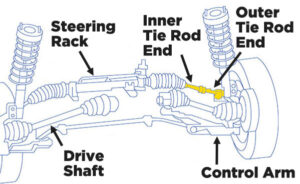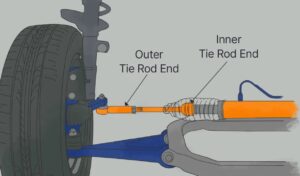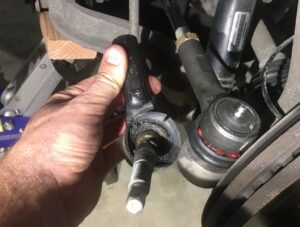A tie rod is a part of the steering system. It connects the steering rack or linkage to the steering knuckles. The steering rack is attached to the vehicle body, frame or sub-frame. Steering knuckles hold the front wheels. When a driver turns the steering wheel, the steering rack slides and the tie rods turn the steering knuckles in the desired direction.

Inner and outer tie rod
A tie rod is made of two components: the inner and outer tie rod ends. Both tie rod ends have small ball joints. The inner tie rod end is greased and protected by the steering rack boot. The outer tie rod end is also filled with grease, but it’s protected by a small rubber or plastic boot.
The most common problem with either tie rod ends is when they wear out and get loose. Often this happens when a rubber boot cracks or breaks and moisture penetrate inside the tie rod end causing corrosion. Outer tie rod ends fail more often. Problems with tie rod ends are more common in heavier cars and SUVs due to greater load. A loose tie rod is a major safety concern as it can separate. If a tie rod end separates, the vehicle will lose steering control. If you have seen a disabled vehicle on the side of the road with the front wheels pointing in different directions, it could be that one of the tie rod ends has separated.


New vs. old outer tie rod
Symptoms of a loose tie rod end include a clunking, rattling or knocking noise in the front end and looseness felt in the steering.
Can a bad tie rod cause shaking? Yes, excessively worn tie rod ends cause looseness in the steering. This might result in shaking in the front end that comes and goes at certain speeds.
Does the vehicle need the wheel alignment after replacing a tie rod end? Yes, tie rods control steering angles. In fact, the tread or clamp connecting inner and outer tie rods is used to adjust steering angles. This means that after the replacement of any of the tie rod ends, the vehicle will need the wheel alignment to bring the steering and suspension angles back to within specifications.
Should tie rod ends be replaced on both sides at the same time? No, if a tie rod is in good shape, there is no need to replace it. However, tie rods on both sides wear out at the same rate. If one tie rod end is bad and the other is starting to go, it makes sense to replace both, so you won’t have to do the wheel alignment twice. Another reason to replace a working tie rod end is when the protective boot is damaged. Once the boot is damaged, the tie rod won’t last long.
Does a tie rod need any maintenance? In some cars and trucks, tie rod ends have grease fittings and must be greased periodically. In many modern cars, tie rod ends don’t need any maintenance as they are filled with grease and sealed at the factory. You can check your owner’s manual or ask your mechanic to check if tie rods have grease fittings during a regular service.
